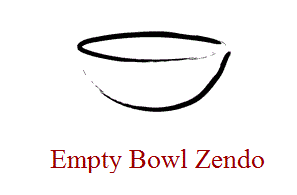BOWING. Why all the bowing? What, or who, are we bowing to? These are questions frequently asked. The answer to each of these questions is relatively simple – at least on the surface. We are bowing to our Buddha nature or the awakened state in ourselves and in each other. Thus, we should bow with mindfulness, reverence, and humility. If we bow too quickly or off-handedly, we may be expressing distraction or dismissiveness. If we bow too slowly or ornately, we may be expressing patronization, superiority, or ego-indulgence.
Maezumi Roshi gave a nice description of the standing bow: “The bow is used upon entering the Zendo, and in greeting one another and our teachers. The body is erect, with the weight distributed evenly and the feet parallel to each other. The appropriate gassho is made. As the bow is made, the body bends at the waist, so that the torso forms an angle with the legs of approximately 45 degrees. The hands (in gassho) do not move relative to the face, but remain in position and move only with the whole body."
Why do we bow to our seat before we do zazen? When we bow to our seat, we are bowing to the seat of our own enlightenment, to the place of our own awakening.


